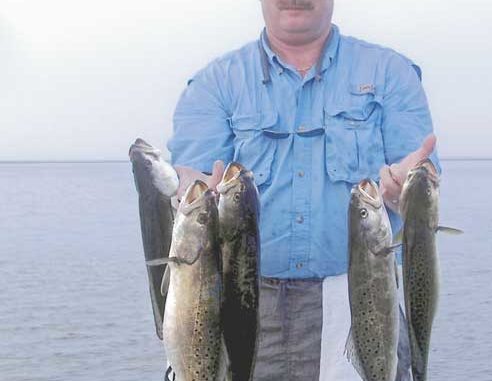
A Wilmington guide likes Speckled Trout Fishing on the surface because that’s when he lands his biggest fish
Lewis Emery of Wilmington prefers one approach to fishing for speckled trout. In fact, he’s almost as hard-core as a mountain fly-fishing purist, although his targets are measured in pounds, not inches.“I like to fish for speckled trout using topwater lures,” said the Wilmington resident, a Bug-Em Bait Company employee who also is a part-time guide (Tails Up Charters, 910-617.2194, www.tailsupcharters.com).
The reason?
“When you’re fishing for specks with topwater lures, that’s when you’ve got the best chance to catch really big ones, at least that’s what happens in my experience,” the 28-year-old said.
No time of year is better for tackling specks with topwater lures than June.
Just before dawn one day last summer, Emery launched his 19-foot Carolina Skiff at the public ramp near the terminus of U.S. 421, just past the Fort Fisher-to-Southport ferry landing.
“We’re going to try the ‘Rocks’ first,” Emery said. “We’ve got really good conditions — it’s overcast, and the tide’s coming in. These fish seem to bite better when there’s not a lot of light, such as at daylight and just before dark and on an incoming tide.”
The “Rocks” is a rock wall extending from the south end of the Fort Fisher State Park Recreation Area toward Bald Head Island. The wall was built in the 1890s by the Army Corps of Engineers to keep river water from diverting through Corncake Inlet (and prevent shoaling in the lower Cape Fear River).
Between the rocks and spit of sand that holds back the Atlantic Ocean are several “bays,” open expanses of shallow water marked by marsh islands and oyster mounds. The northernmost bay is First Bay (aka The Basin), then comes Second Bay, then Buzzard’s Bay. Zeke’s Island, No Name Island and North Island also are to the east of the “Rocks.”
Emery’s topwater weapon of choice for speckled trout is a
6 1/2-foot light rod with a short, 6-inch butt, spooled with 10-pound-test braided line and from 12 inches to 2 feet of 10-pound-test fluorocarbon leader.
“You really want a light rod and reel with a short butt,” he said. “Using a heavy rod will wear out your arms and wrists because of the way you have to work topwater lures.”
His favorite topwater lure choices include Heddon Super Spook Juniors, Rapala Skitter Walks, MirrOlure Top Pups, Yo-Zuri Banana Boats and MirrOlure prop lures.
“I really like the new new Shimano Stradic FI 3000 (spinning) reels,” Emery said. “They’re the best at not tangling braided line. They’re very good at keeping your line level so you can throw a little farther. How far you throw (a lure) depends on the lure, but you really can sling a topwater lure with a Stradic. It out throws other (reels) by 20 feet.”
Emery said long casts are important when fishing topwater lures because specks can be finicky and often will stalk a lure before striking. The longer a lure is in the water the more time a trout has to strike.
“I’ve had trout follow a topwater lure right to the boat before they hit,” Emery said. “That’ll put a charge in you when they blow up right at the boat.
“My leader (lengths) vary, depending on how many times I’m expecting to change lures that day. I also like to have something to grab so I can swing a trout right into the boat and not have to stop and find a net.
“But you can catch trout by tying (a lure) right to the braid if they’re feeding; some days you don’t need a leader.”
Emery said he’s never certain what mood specks will be in, nor what type of topwater lure, color or retrieve they’ll favor. However, he often has a way to figure out those answers.
“If I’ve got two other anglers with me, I usually have each one try one of three cast-and-retrieves to see what (the specks) want,” Emery said.
They include a quick return, a slow return and a twitch-and-wait approach.
“Usually I’ll have one guy ‘walk’ (a lure) quickly; another will move it slowly; the other will twitch and pause,” Emery said. “(Trout) usually are gonna like one of those (retrieves). When we figure out which one they like best, we’re set.”
The best conditions for early morning or late evening topwater speckled trout fishing include overcast skies and calm winds.
“The calmer and glassier conditions the better,” Emery said. “You usually can’t catch (speckled trout) in rippling water (with topwater lures) because it takes away (the advantage) of the noise (of the lures) when you twitch them. Most of the topwater trout lures actually don’t make that much noise.”
If a client is determined to try topwater fishing, even with a choppy surface, Emery said the best bet is a Super Spook Junior.
“It’ll work in calm conditions or even when there’s a little chop,” he said.
As for lure colors, Emery uses a tactic bass anglers discovered years ago — they use dark lure colors during low-light conditions and bright colors when the sun is shining.
“In the mornings or evenings, if it’s overcast, I’ll throw a lure with a black belly,” he said.
Emery said the upper halves of topwater lures aren’t crucial to eliciting strikes from trout but are aimed at other customers.
“Think about it,” he said. “The lure’s on the surface, so the fish only sees the bottom. The color (on the top) is more for catching fishermen than fish.”
However, sometimes Emery uses a topwater trout lure that sports an orange or chartreuse belly.
“Chartreuse stands out well in the evening,” he said. “I don’t know why; it just works. At night, black is definitely the best (belly) color.”
These lures aren’t large because speckled trout eat small baitfish (which are all that are available during the spring).
“The (lure) sizes range from 3- to 3 1/2-inches long,” Emery said. “The biggest lure of this type I use for trout is 3 1/2 inches.
“(Trout) feed on smaller baits — glass minnows, little menhaden, small mullets and mud minnows, little pinfish or tiny croakers. That’s why you use small lures — to match that hatch.”
Emery said available baitfishes also dictate his most effective retrieval methods.
“(Small natural baitfish) is why you pop and twitch (lures),” he said. “That’s what those little baitfish do; they don’t just swim along at a steady speed — they dart, then stop.”
Most inshore anglers have seen a school of minnows “flash” in the water as they speed away when frightened (often by a predator), then they’ll settle down.
To duplicate that action, Emery likes 74MR Top Pop and 75MR She-Pup MirrOlures, along with Rapala Skitterwalks because they mimic small baitfishes.
Another favored speckled trout lures is the 808 MirrOlure (black, gold and orange).
“Rapala has a similar lure called the little Skitterwalk (SW8),” he said. “The (gold-and-sardine color) Super Spook by Heddon, the GS, is my No. 1 favorite color.”
However, Emery doesn’t use lures right out of the box. He seeks every edge he can because specks, especially top-water feeding trout, often are finicky eaters that swirl, roll or slap at lures, sometimes missing the hooks. When specks are striking at but missing lures, Emery’s solution is to change hooks.
“There’s a VMC hook, the 5537 4x treble, I think was invented or used a lot by David Fritts, the bass (tournament) guy,” Emery said. “It’s great for better hookups.”
When he gets ready to use a topwater speck lure, Emery immediately installs VMC trebles.
“If you change out and use VMC hooks, you’ll get a better hook-up ratio,” he said. “You’ll foul hook a lot more fish, and they’ll stay hooked; you’ll hook ’em in their bellies and tails.
“If it’s at the end of the day, and fish are really wary, a lot of times they’ll swipe and miss hooks. With these (VMC) hooks, you’ll won’t miss many.”
He also employs artificial scent on his lures.
“I use Carolina Lunker Sauce,” he said. “I put menhaden, shad or mullet flavors on hard baits and shrimp scent on shrimp lures.”
If specks still miss topwater lures, Emery sometimes casts a small X-Rap lure “behind them. If they miss a topwater (lure), they’ll often come right back and hit the X-Rap.”
Excellent overall places to look for spring speckled trout include oyster beds near fairly deep water, Emery said.
“If there’s an oyster bed and a channel next to it, that’s a perfect place,” he said. “The trout get right next to (the shell bed). If the tide’s in, and water covers (the oyster bed), they’ll get on top of it. But it has to be near deep water.”
By deep water, he meant water that’s 4- to 15-feet deep.
When he’s fishes inshore waters in marshes and creeks, Emery said he also finds speckled trout suspended near points and marsh banks, again, near deeper channels.
“Sometimes you’ll be in deep water, casting to a bank and a speck will hit (a lure) right next to the boat in 10 to 15 feet of water,” he said.
“Speckled trout in this area of North Carolina are usually ledge fish,” he said. “If there’s a bunch of oyster beds in a place and the water (temperature) is higher than 60 degrees, you’re gonna have specks.”
The best temperature range for speckled trout activity seems to be 58 to 83 degrees.
“The coldest I ever caught trout was 58 degrees, but that’s when I’ve caught some of my biggest ones,” Emery said. “When it’s that cold, I’ll just twitch (a topwater lure) once and let it sit. When you catch them at 83 degrees, it’s usually at night in the summer.”
Near Southport, the top places for specks include the bays above Bald Head, the Elizabeth River and Battery Island near the mouth of the Cape Fear River.
If the topwater bite has slowed by mid morning, Emery sometimes uses a DOA shrimp with a popping cork float.
“That’s an excellent rig when they’re not hitting topwater,” he said.
Sometimes when trout are actively striking at lures but missing hooks, Emery said the fish are smaller. So he changes to even smaller lures.
“I’ll throw a Betts Halo Shrimp or Yo-Zuri 3-D Fingerling,” he said. “They get under the surface 2 or 3 feet. They’re expensive (lures), but they work. I also change out the hooks.”
Emery said “green” (clear) waters is always better for speckled trout, but sometimes the water near Southport is murky.
“Certain places (for trout) here are river systems,” he said. “That’s when you have to use dark-colored lures, orange and black, the DOA color. A good river color is the Electric Chicken.”
Other effective trout lures when the water’s dark and there’s a little chop on the surface include the new MirrOminnow (“It looks like a 3 1/2-inch-long glass minnow”) or the MirrODine (“It looks like a 3-inch-long menhaden”).
“You’ll get a better hookup ratio with these sub-surface lures,” Emery said.
His best speckled trout in 2007 weighed 6 pounds. During his top days, Emery said he has caught 40 to 50 trout in 3 to 4 hours.
“You can have 100-fish days if you go up the (Cape Fear) river, but I don’t go up there,” he said.
Emery also tries to time his topwater fishing with the incoming tide.
“The best conditions include clear water, overcast skies, and an incoming tide,” he said. “That’s when trout will go near grass (at islands) and oyster beds.”
But even when the tide turns and starts to fall, he said if he’s found good numbers of fish, he still can whack them.
“They’ll start creeping down at the deeper parts of the ledges with the outgoing tide,” he said.
If he locates a group of specks at a hole during low tide, he’ll stay at that spot until the school moves.
“They won’t stay at one spot, so you have to move and look for them,” he said. “If you stop getting bites (at a spot), move and throw a topwater (lure), then a sub-surface lure, then something that goes deeper, like a DOA shrimp, grubhead with a green curlytail or Electric Chicken (color) until you start getting bit again.”
Emery said specks appear to be “pretty lazy fish because they like to be near current but out of the current. You might catch a few in the current but not many. The only time they’ll be in current you’ll find them deeper in 4 to 8 feet of water when (the temperature) is hot.”
One of the best places to find feeding specks, he said, is the down-current side of a sand island covered with marsh grass.
“You want to be where the current is running around the island,” he said. “Trout have the option to be out of the current but near current. A floating DOA shrimp can be deadly there.”
When he’s drift fishing, Emery doesn’t like to use his Minn-Kota trolling motor.
“You want to drift with the wind and current as much as you can, cover a lot of water (with casts) and not turn on the trolling motor,” he said.
Emery said speckled trout of the same size will school but larger fish usually will be nearby.
“If you’re catching 3-pounders on every cast, just wait until evening,” he said. “At the Rocks, if you’re using float rigs to catch smaller (specks), at dusk you have a chance to catch some really big fish with topwater lures.
“And that’s a chance I never pass up.”

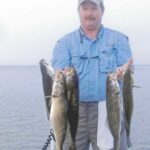
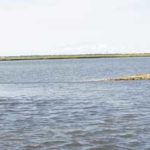
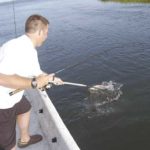

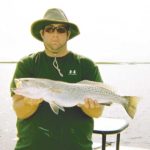



Be the first to comment